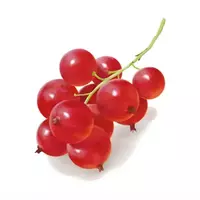Currant red

Western Europe is generally considered the birthplace of redcurrant. The decorative properties of red currant are widely known. Initially, red currants were much more common than black currants.
This situation did not change until the early 20th century. And even if at present red currants are not so often found in the garden plots of our compatriots, but connoisseurs of this berry know not only the wonderful taste of this beautiful berry, but also the numerous useful properties of red currants. Initially, red currants were grown exclusively for medicinal purposes and this is not at all accidental.
Red currant benefits
People have known about the benefits of red currants since time immemorial. Despite the fact that the composition of the red currant is significantly inferior to its black "sister, " it also has something to brag about. For example, red currants contain a unique substance called oxycoumarin, which has an extremely beneficial effect on normal blood clotting. This property is extremely useful for the prevention of heart attacks. Accordingly, eating red currants has an incomparable positive effect on the state of blood vessels and the cardiovascular system as a whole.
Vitamin C in red currant is slightly less than in black, but in this indicator it significantly exceeds lemons and oranges. The pectins included in this berry contribute to the elimination of unwanted cholesterol from the body, thereby providing invaluable assistance in the prevention of atherosclerosis.
The benefits of red currants are evidenced by its wonderful antipyretic and sweatshop effect, as well as antitumor and painkiller effects. In addition, red currant contributes to the normalization of the digestion process, is an excellent choleretic agent.
It is worth talking about the methods of drinking red currants. Of course, it is best to consume this berry fresh. It is impossible to store red currants for a long time, however, in frozen form, red currants can be stored for a long time and at the same time preserve most of their nutrients. In addition to freezing, red currants are very often preserved, numerous desserts, compotes, jam, jelly, juices, fruit drinks, kvasses are prepared from it, and even added to sauces, soups and salads. The calorie content of red currant is 43 kcal. per 100 gr, which is the average among similar products.
Red currant harm
Despite the obvious benefit of this berry, one cannot fail to mention the dangers of red currants. Contraindications to its use can be peptic ulcers, hepatitis, gastritis during its exacerbation. Red currants should be eliminated for people with hemophilia and low blood clotting.
red currants 43 kCal
The energy value of red currants (Ratio of proteins, fats, carbohydrates - ju):
Proteins: 0.6 g (~ 2 kCal)
Fats: 0.2 g (~ 2 kCal)
Carbohydrates: 7.7 g (~ 31 kCal)
Energy ratio (bj | y): 6% | 4% | 72%
 Español
Español Français
Français Português
Português Русский
Русский 简体中文
简体中文 繁體中文
繁體中文 日本語
日本語 한국어
한국어 العربية
العربية Türkçe
Türkçe Қазақ
Қазақ Deutsch
Deutsch Italiano
Italiano Українська
Українська
